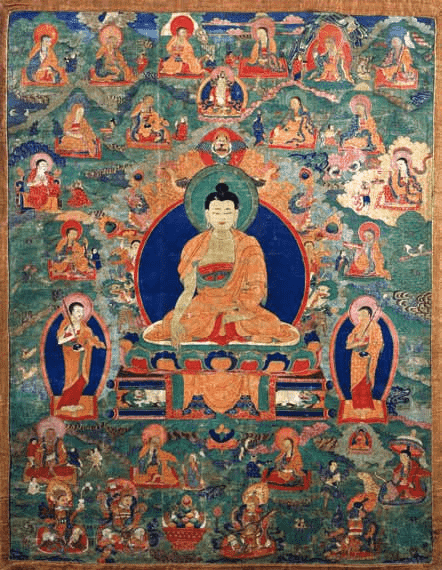“Foe Destroyer,” the English translation of the Tibetan dgra bcom pa (pronounced dra chom pa) may sound like an old-fashioned or unusual term. Why did Tibetan translators choose this translation for the Pali and Sanskrit term arhat?
Foe Destroyer or Worthy One?
Traditionally, scholars of Indic languages claimed that arhat comes from the root arh–this means “to be worthy,” or “to deserve.” An arhat, the culmination of the path of the hearers, or śrāvakayāna, was “a worthy one,” or “one deserving of praise.” Thus many translators of Theravada Buddhism use the term “worthy one” or “perfected one.”
Sometimes we find this translation rendered into Tibetan as mchod ‘os (phonetically chö ö). In English, that would translate to “worthy of praise.” And we do find within the Tibetan canon, written praises to the arhats. For a lovely example, read Jamyang Khyentse Wangpo’s text for praise and offerings to the sixteen arhats. This beautiful composition describes the sixteen arhats in great detail.
What Foes?
Still, most Tibetan translators did not use this translation. Instead, they began to standardize the term dra chom pa that we translate as “foe destroyer” or “enemy destroyer.” It is clear that the early translators knew the etymology of the word and were familiar with its usage. However, they chose to favor a more meaning-oriented hermeneutical translation. An arhat is so designated “because he has killed the enemies” of disturbing emotions or afflictions.
Interestingly, the modern scholar of Theravada Buddhism and expert on the Pali language, Richard Gombrich, argues that the etymology chosen by the Tibetans is probably more accurate. Just as the Tibetan translators understood the term, he argues that the Jains also referred to arhats and to jinas, or “conquerors.” And their languages used two vernacular, or Prakrit forms of the word arahanta and arihanta. It seems very likely that the original etymology was ari (meaning enemy) + hanta which we could translate as destroyer. And it is noteworthy that the Theravada Abhidhamma does specifically refer to an arhat as one who is “a destroyer of taints.”
Both Jain and Buddhist followers underlined the spiritual power of their adepts, rather than promoting their magical powers. The arhat exemplified the pinnacle of the common vehicle of Buddhism. He or she was one who had truly conquered his or her negative afflictions. Thus, he or she had earned the title of Foe Destroyer for vanquishing the internal enemy.



